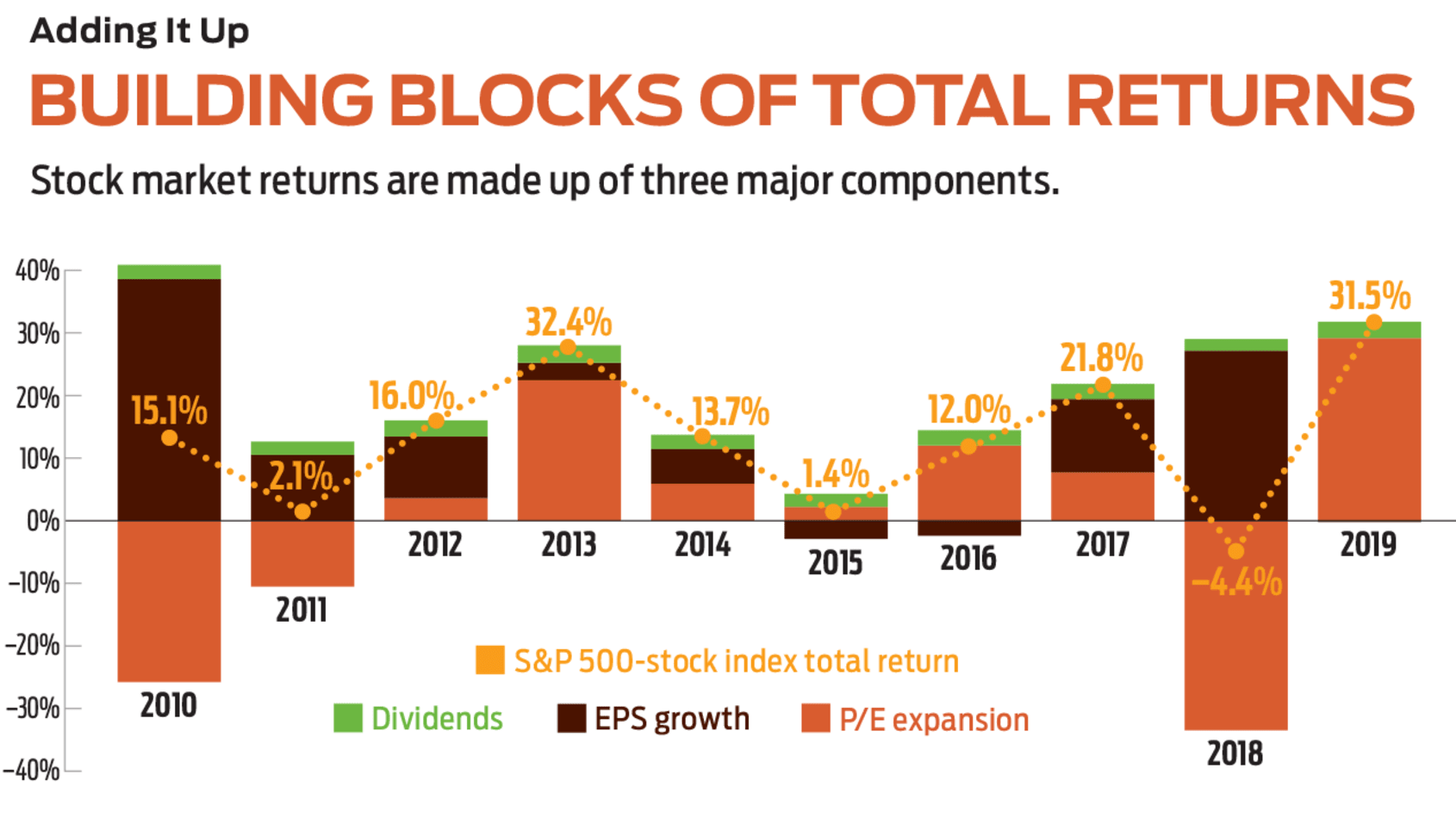What Drives Stock Returns?
Hint: It’s more than just company profits.


We’re told over and over that growth in corporate earnings drives stock market returns. If that’s the case, what has been going on lately? In 2019, Standard & Poor’s 500-stock index posted a total return of 32%, but corporate earnings barely moved. In 2018, with corporate profits solidly up, the market surrendered 4.4%. The truth is, earnings are only part of the picture when it comes to stock market returns. Understanding the whole mosaic can give you insight on how to manage your portfolio.
You can divide stock returns into three primary drivers, which can work in concert or at odds: earnings growth, valuation and dividends. In a vacuum, earnings growth is the easiest to understand. Say a stock costs $100 per share and posts earnings of $10 per share. If earnings grow by 5%, to $10.50, then the stock price should grow by a commensurate 5%, to $105, producing a 5% return.
But stock prices reflect what investors expect in the future. Their confidence or negativity about a stock’s potential is expressed in its valuation, commonly represented by a measure such as the price-earnings ratio. If investors are bullish on a stock, they’ll bid up the price, thus “expanding” the stock’s price-earnings multiple and boosting return.
From just $107.88 $24.99 for Kiplinger Personal Finance
Become a smarter, better informed investor. Subscribe from just $107.88 $24.99, plus get up to 4 Special Issues

Sign up for Kiplinger’s Free Newsletters
Profit and prosper with the best of expert advice on investing, taxes, retirement, personal finance and more - straight to your e-mail.
Profit and prosper with the best of expert advice - straight to your e-mail.
Say the $100 stock with $10 in earnings has a P/E of 10. Should confident investors bid the price up to 12 times earnings, the stock would now trade at $120, a 20% return. In 2019, 29 percentage points of the S&P 500’s 32% return came from valuation expansion. “Valuation expansion last year was in anticipation of earnings growth this year,” says analyst Willie Delwiche, at investment firm Baird.
Understanding where the market’s valuation stands compared with historical averages can give investors a sense of market risk, says Delwiche, because valuations tend to revert to mean levels over time. At 18 times expected year-ahead earnings, the S&P 500 trades above the 10-year average of 15. That doesn’t mean prices will come down imminently, Delwiche says, but it could signify that investors should explore less-volatile pockets of the market or consider investing overseas, where stocks are trading closer to historical norms.
Count on dividends. Income investors know the power of the third major driver of total returns: dividends. Since 1955, earnings growth has contributed 63% of the S&P 500’s total annual return, on average, followed by dividend payments (28%) and expansions or contractions in valuation (9%), according to Calamos Wealth Management.

Of those factors, dividends are the least volatile and don’t ever detract from the market’s return. As a result, reinvested dividends have an outsize impact on the market’s return over time. From the end of 1970 through 2019, 78% of the total return of the S&P 500 came from the compound growth of reinvested dividends, according to analysts at the Hartford Funds. The message is clear, says CFRA investment chief Sam Stovall: “Dividends reward the buy-and-hold investor.”
What will drive returns in 2020? Calamos Wealth Management chief investment officer Reed Murphy believes the baseline case is for valuations to hold relatively steady and for earnings growth for companies in the S&P 500 to come in below current estimates of 9%-plus. He suggests the S&P 500 is likely to return 7% to 8% in 2020, including a 1.9% dividend yield.
Profit and prosper with the best of Kiplinger's advice on investing, taxes, retirement, personal finance and much more. Delivered daily. Enter your email in the box and click Sign Me Up.

Ryan joined Kiplinger in the fall of 2013. He wrote and fact-checked stories that appeared in Kiplinger's Personal Finance magazine and on Kiplinger.com. He previously interned for the CBS Evening News investigative team and worked as a copy editor and features columnist at the GW Hatchet. He holds a BA in English and creative writing from George Washington University.
-
 Stocks Extend Losing Streak After Fed Minutes: Stock Market Today
Stocks Extend Losing Streak After Fed Minutes: Stock Market TodayThe Santa Claus Rally is officially at risk after the S&P 500's third straight loss.
-
 What Bilt Cardholders Need to Know as Wells Fargo Exits the Program
What Bilt Cardholders Need to Know as Wells Fargo Exits the ProgramA major shake-up in the Bilt Rewards program could affect your credit card, rent rewards and points strategy heading into 2026.
-
 3 Major Changes to the Charitable Deduction in 2026
3 Major Changes to the Charitable Deduction in 2026Tax Breaks About 144 million Americans might qualify for the 2026 universal charity deduction, while high earners face new IRS limits. Here's what to know.
-
 Stocks Extend Losing Streak After Fed Minutes: Stock Market Today
Stocks Extend Losing Streak After Fed Minutes: Stock Market TodayThe Santa Claus Rally is officially at risk after the S&P 500's third straight loss.
-
 Santa Claus Rally at Risk as Tech Stocks Slump: Stock Market Today
Santa Claus Rally at Risk as Tech Stocks Slump: Stock Market TodayThe Nasdaq Composite and Dow Jones Industrial Average led today's declines as investors took profits on high-flying tech stocks.
-
 Gold and Silver Shine as Stocks Chop: Stock Market Today
Gold and Silver Shine as Stocks Chop: Stock Market TodayStocks struggled in Friday's low-volume session, but the losses weren't enough to put the Santa Claus Rally at risk.
-
 The Santa Claus Rally Officially Begins: Stock Market Today
The Santa Claus Rally Officially Begins: Stock Market TodayThe Santa Claus Rally is officially on as of Wednesday's closing bell, and initial returns are positive.
-
 'Humbug!' Say Consumers, Despite Hot GDP: Stock Market Today
'Humbug!' Say Consumers, Despite Hot GDP: Stock Market Today"The stock market is not the economy," they say, but both things are up. Yet one survey says people are still feeling down in the middle of this complex season.
-
 Stocks Rise to the Spirit of the Season: Stock Market Today
Stocks Rise to the Spirit of the Season: Stock Market TodayInvestors, traders and speculators are beginning to like the looks of a potential year-end rally.
-
 Nasdaq Leads as Tech Stages Late-Week Comeback: Stock Market Today
Nasdaq Leads as Tech Stages Late-Week Comeback: Stock Market TodayOracle stock boosted the tech sector on Friday after the company became co-owner of TikTok's U.S. operations.
-
 Cooler Inflation Supports a Relief Rally: Stock Market Today
Cooler Inflation Supports a Relief Rally: Stock Market TodayInvestors, traders and speculators welcome much-better-than-hoped-for core CPI data on top of optimism-renewing AI earnings.